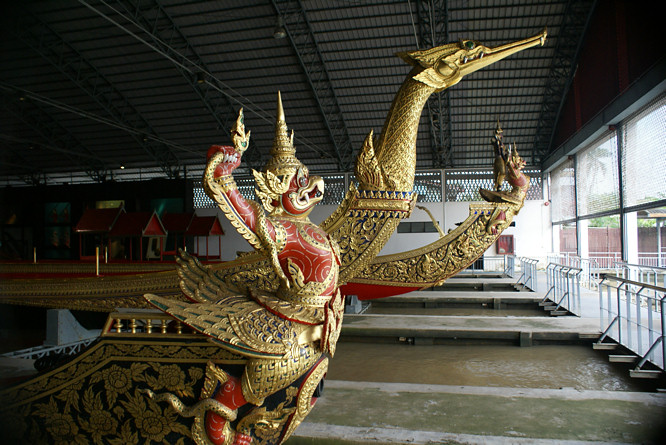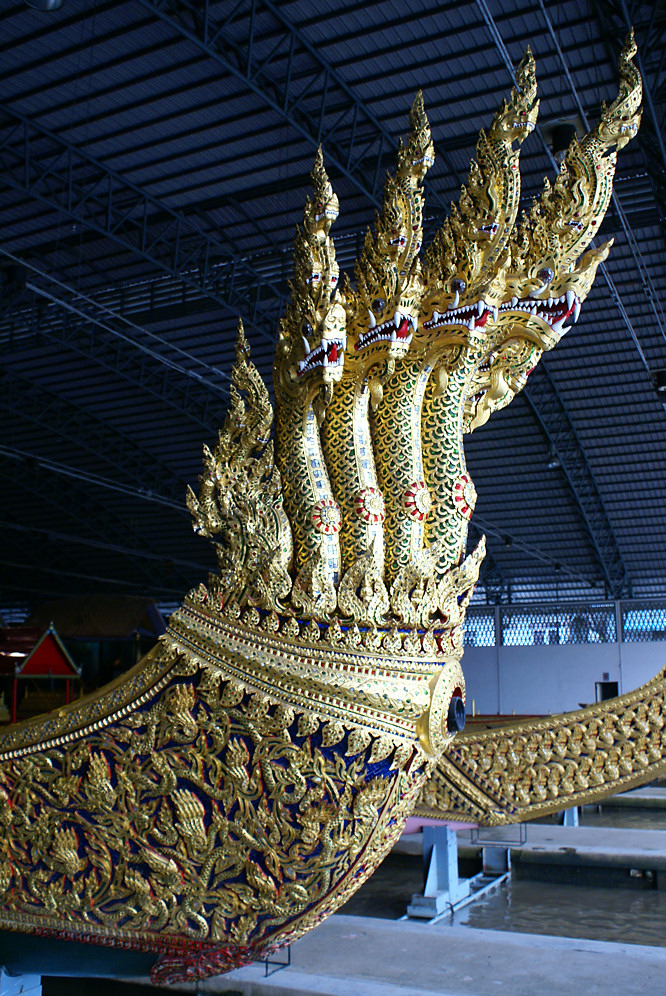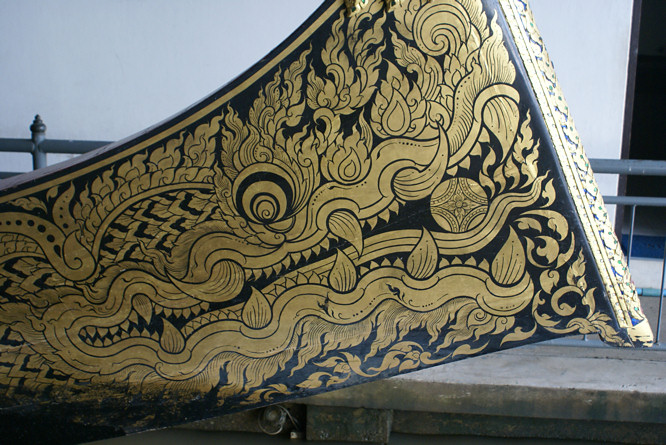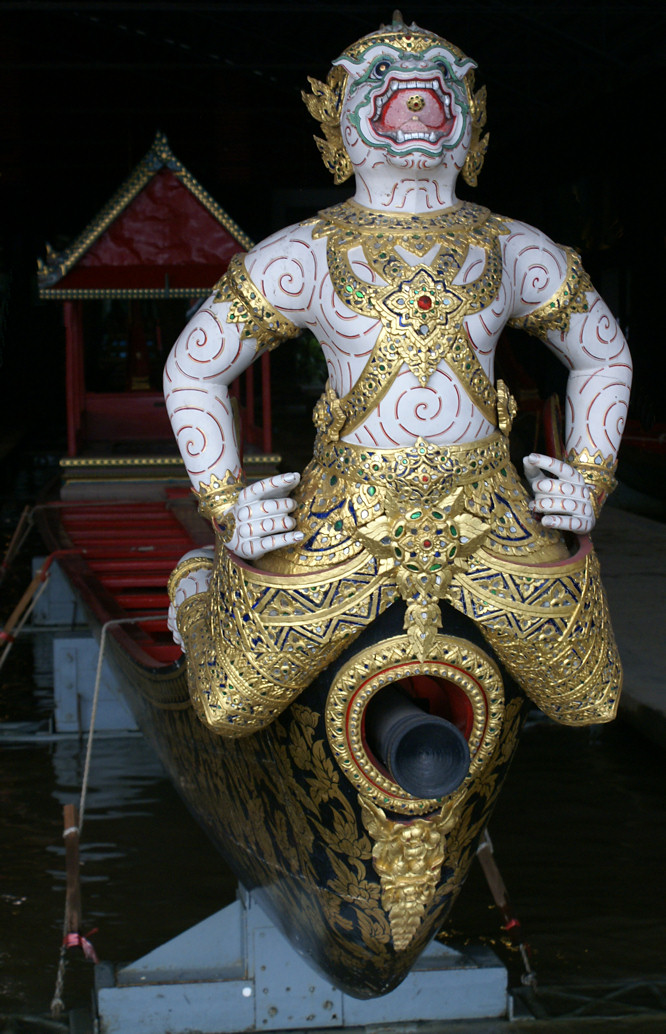Bangkok Royal Barge Boat House Museum
The Bangkok Royal Barge Museum on the banks of the Noi canal off the Choa Phraya river is where the King parks his magnificent collection of ceremonial dragon long boats.

He has kindly allowed his subjects and foreign tourists to inspect them close up. It is a very unusual and unique Museum. Originally warcraft, the tradition of barge processions can be dated back to the early 13th century.
Over the past 400 years in Bangkok the main Chao Phraya River and its tributaries were the most important way of getting around and transporting goods. The Thai Royal Family also had to use the water to move around their capital city. Eight of Thailand's most unique and stunning Royal Barges are on display out of more than fifty long boats owned by the King.
These eight are the reserved for auspicious religious and Royal ceremonies as well as state occasions. In 1685 the Abbot of Choisy wrote a report back to the French court about witnessing hundreds of barges on the river Chao Phraya including many of Royal barges.

Each prow is carved from large pieces of teak. The boats figure head are carved mythical creatures, gilded in gold. They are painted and decorated with tiny pieces of glass. When in use they are rowed by up to 50 oarsmen.
After the 1932 coup where the Monarchy was reduced to a constitutional Monarchy the state took control of a lot of Royal property including the Royal Barges. The feel into disrepair through lack of use. They were also damaged by a Japanese bomb in WW2. After the war when the new king came to the throne he started the restoration of the long boats.
He also reintroduced the Katin ceremony. The Royal barges are used during the ancient Katin ceremony held in October or November that celebrates the end of the rainy season. The Royal family travels down the Chao Phraya River to the Wat Arun temple where the king gives the Monks new robes.
The Royal barges are in berths and raised above the water level in the dock. The personal barge of the King has a figurehead prow in the shape of a huge golden swan. It is called the Suppanahong and was initially built by King Rama I, then rebuilt by King Rama V. Personally I think it looks like a golden dragon's head rather then a swan's. The boat was carved out of a single teak tree trunk. The reason a swan was chosen was because it is supposed to represent the mythical steed of the Hindu god Brahma.

Next to it is the Narai Song Suban H M King Rama IX. Its prow has a carving of King Narai riding a red and gold mythical creature called a Garuda. Notice the bow gun poking out just under the Garuda's body. This Royal Barge was launched on 05 April 1996 to commemorate the 50th anniversary of His Majesty King Rama IX accession to the throne.
The royal barge with a seven-headed golden Naga sprouting from the bow is called the Anantanakharat. Notice it also has bow gun poking out.
The Anekchatphuchong was first constructed during the reign of King Rama IV. The current version on display at the museum was launched in 1914.
There are four smaller Royal escort barges on display. On I particularly liked was the Ekachai class barge because of the intricate painting of a dragon on its side in gold on a black background.

Another Royal escort barge is the Krabi. It has the Monkey god as a figurehead. It also has a bow gun. A Garuda mythical creature in flight features on another boat but this time on its own and not being ridden by a king. It also has a bow gun. Another Royal escort barge is the Asura Vayupak has a half bird and half ogre figurehead. It also has a bow gun.
Around the sides and back of the Museum are display cases with oars, flags and the decorated canopies that go on the top of the barges. The admission fee to get into the Museum is reasonable but if you want to take pictures you have to pay an additional fee that is the equivalent of three entrance tickets. It is open 9am to 5pm.
The best way to get to the Royal Barge Museum is by boat. It has its own pier. It can also be the most expensive way if you hire a water taxi. Most of the long tailed boat canal tours call in at the Royal Barge Museum. For those on a budget ask a tuk-tuk or taxi to take you to the museum. They will stop in the middle of a street near a sign which points to the Royal Barge Museum down an alley way. You are in the right place. On foot you have to negotiate a maze of back alleys for about five minutes until you find the entrance.
Some of the more enterprising house owners have set up small shops to catch the passing tourist trade. It is a bit nerve racking walking down these alleyways. You feel very exposed to being mugged. It is probably a very safe area but it just did not feel right. It may be expensive but I would recommend visiting the museum by boat. The Chaophraya Tourist Boat stops right at the museum. You can take a ferry to Tha Rot Fai pier, walk west along the street parallel to the Klong (canal) until you come to a bridge over the Klong, cross the bridge and follow the walkway.
Travel books

